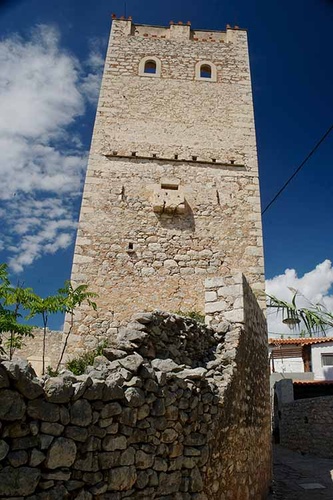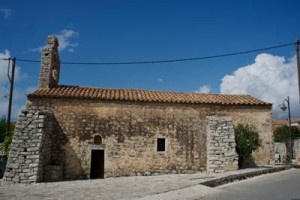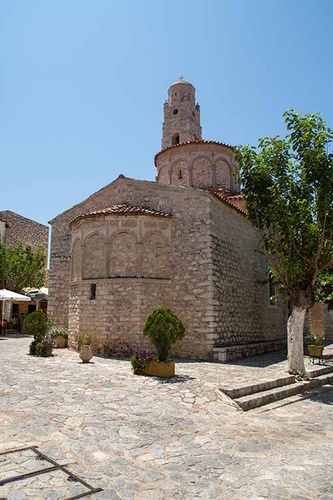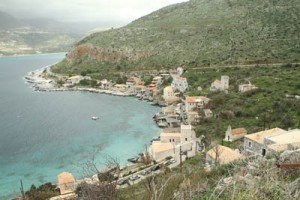Areopolis: a stroll on the path of tradition and history…
Description of the route
The route inside the historic city starts from the central square where the statue of the leader of the 1821 Revolution, Petrompeis Mavromichalis, stands. From there, take the paved street that leads to March 17th 1821 Square, next to the church of the Archangels with its characteristic reliefs. After a short stop at one of the quaint coffee shops, return to the central square and take the street that is parallel to the paved one and leads to Pikoulakis Museum. The permanent exhibition of the Museum, which is part of the Mani Museums Network, is entitled “Stories of Religious Faith in Mani”. At a short distance from Pikoulakis Museum, there is a church that used to belong to the Mavromichalis family, called Panagia Georgianiki. Back to the square, you can visit the Riding Club Museum, next to the building of the Areopolis Public Library. Near the village Ksifarianika, not far from Areopolis, stands the Monastery of All Saints, a church belonging to the Ksifarianos family, the members of which gather there every year to celebrate the memory of the saints.
Instructions for visitors
Areopolis is a year-round destination that retains its traditional character and architecture. The town attracts many visitors especially during the summer months and the three-day celebration (March 15-17) held each year to celebrate the anniversary of the uprising against the Turks. The Pikoulakis Tower hosts a particularly remarkable exhibition, which can be visited throughout the year, Tuesday-Sunday, 8.30-15.00.
Recreation Information
You have the opportunity to wander the cobbled streets that spread under the imposing shadows of the towers and taste local flavours at the small, quaint taverns. Enjoying your coffee while chatting with locals at the quaint coffee shops of the lively paved street, especially in summer nights, is a unique experience. If you want to extend your visit, you can choose among the numerous quaint stone boutique hotels, overlooking the sea, built according to the traditional architecture of Mani. Do not miss visiting Spilioi on the western end of Areopolis where you can enjoy the most beautiful sunset from a spot overlooking the Messinian Gulf.
Built on a rocky plateau overlooking the Messinian Gulf, Areopolis, was the homeland of the strong Mavromichalis family. It is the land of national heroes and freedom fighters of the war for independence and is named after the ancient Greek god of war, Aris (Mars). Over the years, it developed into an important commercial centre. The towers, the mansions and the Palace of the Mavromichalis family in Limeni are living proof of the power and prosperity of the past.
Point A – Statue of Petrompeis Mavromichalis at the central square
According to legend, the historic Mavromichalis family is descended from a fairy that Giorgis Mauromichalis managed, with deception, to make his wife. A strong family, they soon prevailed and consolidated their dominance in the region having Limeni as their base. The family paid a heavy toll during the Independence War: 69 of its members died on the battlefield, among them one of the pioneers and Commander in Chief of the war in the Peloponnese, Petrompeis Mauromichalis, whose statue dominates the impressive central square of the city.
Point B – The double church
At a short distance from the square, you come across the double church of Panagia and St Charalampos, at Niarchakou Square, with frescoes dating back to 1869 and an interesting stepped steeple with stone reliefs. Light a candle and then, just across the street, browse through one of the oldest grocery stores in the area, which keeps its traditional character unchanged.
Point C – Church of the Taxiarches (Archangels)
Built at the end of the central, cobbled road leading to March 17th 1821 Square, the church of the Taxiarches stands out for its rich relief decoration. The icons of the military saints on the lintel of the church as well as the depiction of the zodiac are of particular interest. On March 17th 1821, in the courtyard of the church, fighters from the surrounding area led by Petrompeis Mavromichalis declared the start of the Revolutionary War. From there, they marched against Kalamata, which they conquered, thus lighting the spark of the Independence War in the Peloponnese.
Point C- Pikoulakis Museum
At a short distance from the Church of the Taxiarches, a restored tower houses a permanent exhibition entitled “Stories of Religious Faith in Mani”. It is an exhibition that presents and interprets the development of Christianity in the Mani peninsula with the help of texts, archaeological remains and archaeological findings (religious books, votive inscriptions, functional objects and utensils). At only a short distance from Pikoulakis Museum is the church of Ioannis Prodromos (John the Baptist) as well as Panagia Georgianiki, a church that used to belong to the Mavromichalis family, with remarkable relief decoration.
Point D – Limeni
The history of the city is inseparable from the history of its natural harbour. Limeni, the headquarters of the commercial activities of the Mavromichalis family, is built in a small cove, along the Aeropolis – Kalamata road. The so-called Mavromichalis Palace and Syssitio, the first residence of Petrompeis Mavromichalis, built in 1762, nowadays a hotel, is living proof of the prosperity and the strategic importance of the village.
Point E – All Saints, Ksifarianika
It is worth visiting the monastery of All Saints, in Ksifarianika, with frescoes dating back to 1767.
Point F – Locating stone beehives
Mani has a long history in beekeeping. The stone apiaries with the stone beehives of the area are over 450 years old and are scattered all around Mani.


